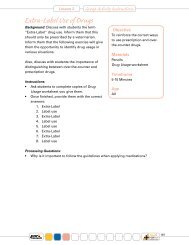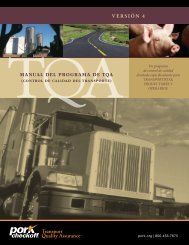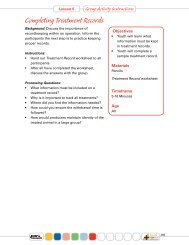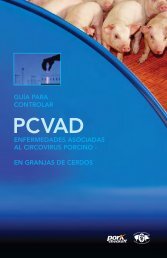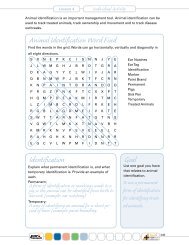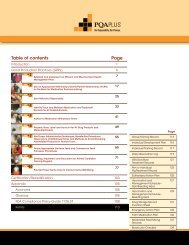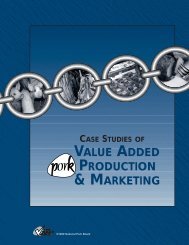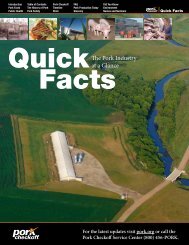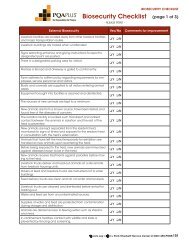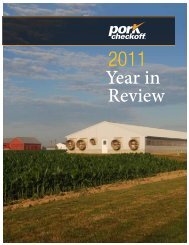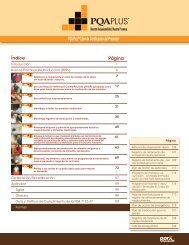PRRS Compendium Producer Edition - National Pork Board
PRRS Compendium Producer Edition - National Pork Board
PRRS Compendium Producer Edition - National Pork Board
You also want an ePaper? Increase the reach of your titles
YUMPU automatically turns print PDFs into web optimized ePapers that Google loves.
standably, <strong>PRRS</strong> virus-free countries had no wish to introduce the virus through the importation of viruscontaminated<br />
pork products if it was determined that ingestion of pork meat was an important route of<br />
transmission.<br />
Several studies have evaluated the presence of <strong>PRRS</strong> virus in meat. Bloemraad et al. (1994) reported that<br />
virus was present, although at low titer, in muscle tissue collected from viremic pigs and that the quantity<br />
of virus was only slightly affected by storage for up to 48h at 4°C (39°F). In a research setting, Magar et al.<br />
(1995b), inoculated 6-month-old pigs with <strong>PRRS</strong> virus and muscle tissue samples were collected at 7 and<br />
14 days post inoculation. Virus was isolated from samples collected 7 days post inoculation but samples<br />
collected 14 days after inoculations were negative. In a slaughterhouse study, muscle tissue samples were<br />
collected from 44 carcasses from herds known to be <strong>PRRS</strong> virus positive but no virus could be isolated.<br />
The investigators concluded that meat does not retain detectable amounts of <strong>PRRS</strong> virus and that transmission<br />
of virus through pork is unlikely. Overall, the data suggest that virus is present at low levels, or<br />
not at all, in the meat of market-aged swine and that the risk of transmission to swine by the consumption<br />
of pig meat is low.<br />
Transmission Within Herds<br />
Once infected, <strong>PRRS</strong> virus tends to circulate within a herd indefinitely. Investigators have reported isolation<br />
of virus from nursery pigs up to 2.5 years after the initial <strong>PRRS</strong> outbreak (Joo and Dee, 1993, Stevenson<br />
et al., 1993). However, spontaneous elimination of <strong>PRRS</strong> virus from commercial herds has been<br />
reported, but the circumstances under which this occurs are not well defined (Freese et al., 1993). The key<br />
components appear to be persistent <strong>PRRS</strong> virus infection in clinically normal carrier animals and the continual<br />
introduction of susceptible animals either through birth or purchase (Wills et al., 1997c). In a typical<br />
scenario, the virus is perpetuated by a cycle of transmission from dams to pigs either in utero or post<br />
partum, or by commingling susceptible animals with infected animals in later stages of production. In<br />
neonatal pigs, maternal antibodies may provide some protection from infection. However, the degree of<br />
protection is not very well characterized and appears to be of short duration. Under conditions in which<br />
susceptible and infectious pigs are mixed, e.g. at weaning, a large proportion of the population may quickly<br />
become infected. Dee and Joo (1994) reported 80-100% of pigs in three swine herds were infected by 8-9<br />
weeks of age and Maes (1997) found 96% of market hogs sampled from 50 herds to be positive. However,<br />
the pattern of infection in <strong>PRRS</strong> virus-endemic herds often deviates from this description of rapid, uniform<br />
spread. Within infected herds, marked differences in infection rates between groups, pens, or rooms of<br />
animals are often observed. Houben et al. (1995) found transmission to vary even within litters, with some<br />
littermates becoming positive as early as 6-8 weeks and other individuals as late as 10 to 12 weeks of age.<br />
In some cases, litters of pigs reached 12 weeks of age, the end of the monitoring period, and still remained<br />
free of <strong>PRRS</strong> virus infection. Thus, it is possible for animals in endemically infected herds to escape infection<br />
for an extended period of time. Dee et al. (1996) concluded that the presence of susceptible animals<br />
in breeding herds provided a mechanism to maintain persistent viral transmission in chronically infected<br />
farms.<br />
Albina et al. (1994) described the mechanisms that allow <strong>PRRS</strong> virus to persist in infected farms as,<br />
1.<br />
2.<br />
3.<br />
4.<br />
5.<br />
Incomplete infection of the susceptible population during the acute phase.<br />
Introduction of new susceptible pigs in the form of replacement breeders.<br />
A persistent viral infection in individual pigs with the potential to excrete virus under certain<br />
conditions, such as animal grouping, farrowing or weaning.<br />
A rapid decrease in maternal immunity, with young pigs becoming susceptible to infection or<br />
re-infection several months later.<br />
Lack of protective immunity, or variable periods of active immunity, in infected pigs.<br />
Transmission Between Herds<br />
Frequently, elimination of <strong>PRRS</strong> virus from herds in swine dense areas is commonly followed by re-introduction<br />
of the virus weeks or months later. The introduction of virus into a herd in the absence of any<br />
apparent animal or human contact is termed “area spread.” Under most circumstances, the source of the<br />
virus is unproven. Possible sources for consideration include the introduction of infected animals or contaminated<br />
fomites onto the premises, or spread via insects, aerosols, water, or non-porcine hosts.<br />
Dee (1992) was the first to recognize the primary role of infected animals in herd-to-herd transmission.<br />
PAGE 0<br />
PIG 04-01-09





